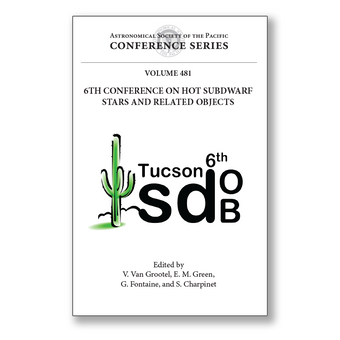Vol. 481 – 6th Meeting on Hot Subdwarf Stars and Related Objects
Your purchase of this volume includes a printed copy and electronic access. With your purchase of this title online, you will receive email instructions on how to access the e-Book version. If you wish to use our printable order form and mail or fax it to us, you will need to include your email address on this form in order to receive electronic access to the purchased volume(s).
Volume CS-481
Editor(s): Van Grootel, V.; Green, E.; Fontaine, G.; Charpinet, S.
Print ISBN: 978-1-58381-846-6
e-Book ISBN: 978-1-58381-847-3
Published: 2014
These are the proceedings of the Sixth International Meeting on Hot Subdwarf Stars and Related Objects held at the University of Arizona, Tucson, in May 2013. The aim of these biennal workshops is to disseminate recent results on the properties, formation, and evolution of hot subdwarf stars and related objects, and to assess the impact of recent results on other areas of astrophysics.
Most hot subdwarfs belong to the B (sdB) type, and are evolved, low-mass, core He-burning stars that populate the Extreme Horizontal Branch (EHB). They have outer H-rich layers so thin that they evolve directly to the white dwarf domain aer core He exhaustion. The less numerous, hotter O (sdO) type subdwarfs make a less homogeneous family than their B counterparts. Some of them descend directly from sdB's on their way to the white dwarf stage, but others descend from the post-asymptotic branch evolutionary phase, while still others are very low mass post-red giant branch stars. Both the sdB and sdO types are found in the field and in some globular clusters.
These proceedings constitute a snapshot of the current research in the field. Topics include the formation of EHB stars, a key question in stellar evolution. Hot subdwarf stars are also an excellent tool for studying stellar evolution in close binary star systems with various companions. Many hot subdwarfs exhibit stellar pulsations, which allows asteroseismology to be used for inferring their fundamental parameters. Hot subdwarf stars and their atmospheres are also a laboratory for studying the effects of diffusion, weak stellar winds, radiative levitation, and gravitational settling.
For more information about this publication and other ASP Conference Series Proceedings, click here (a new browser window will open).


